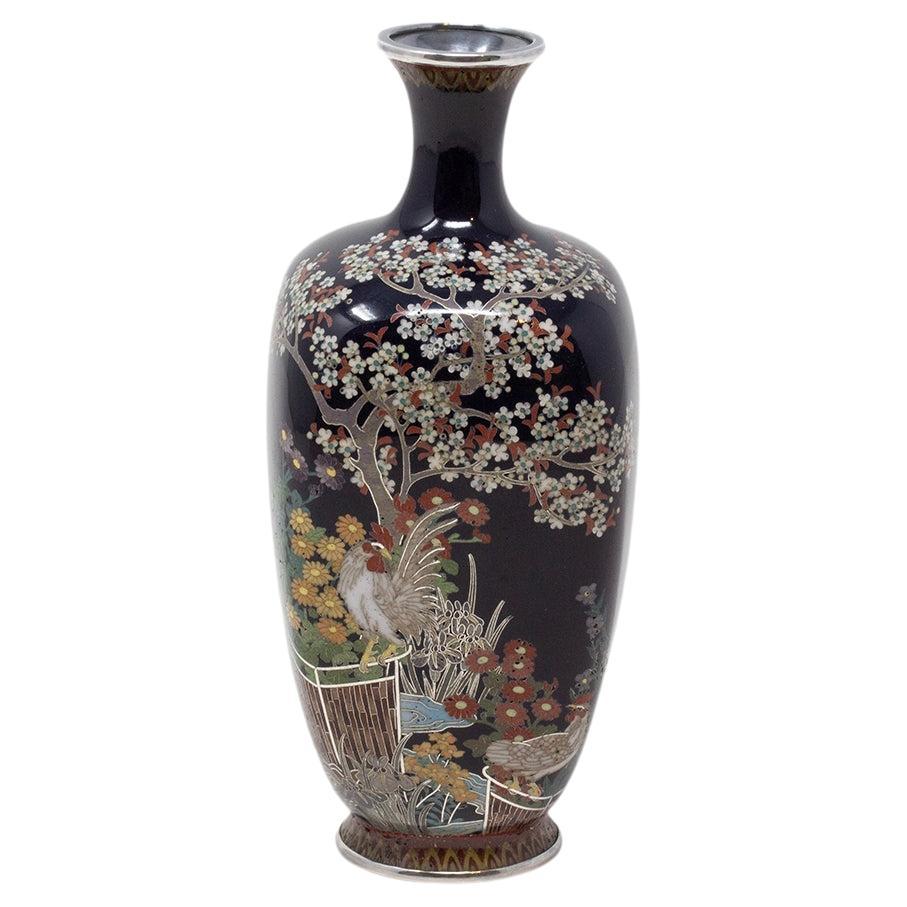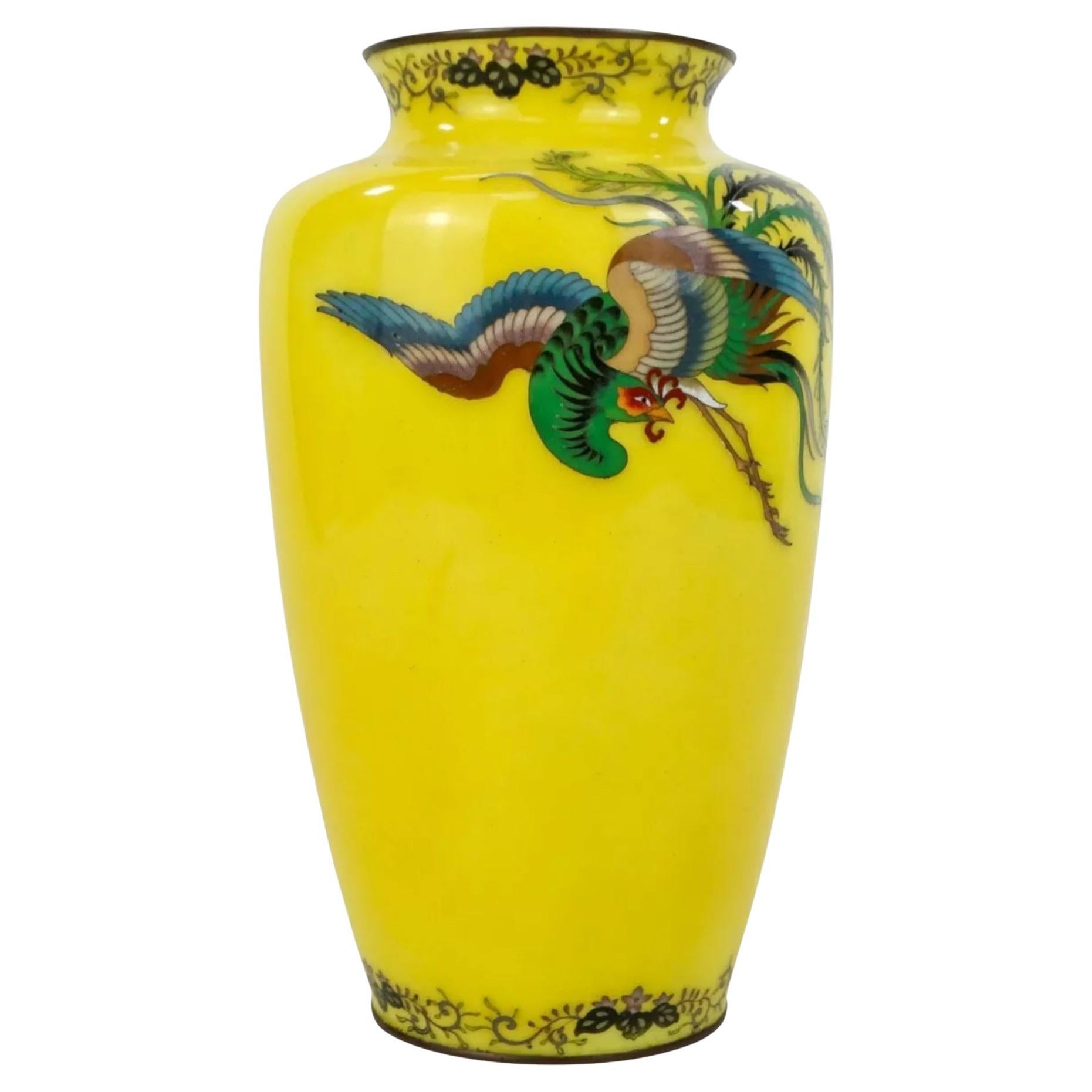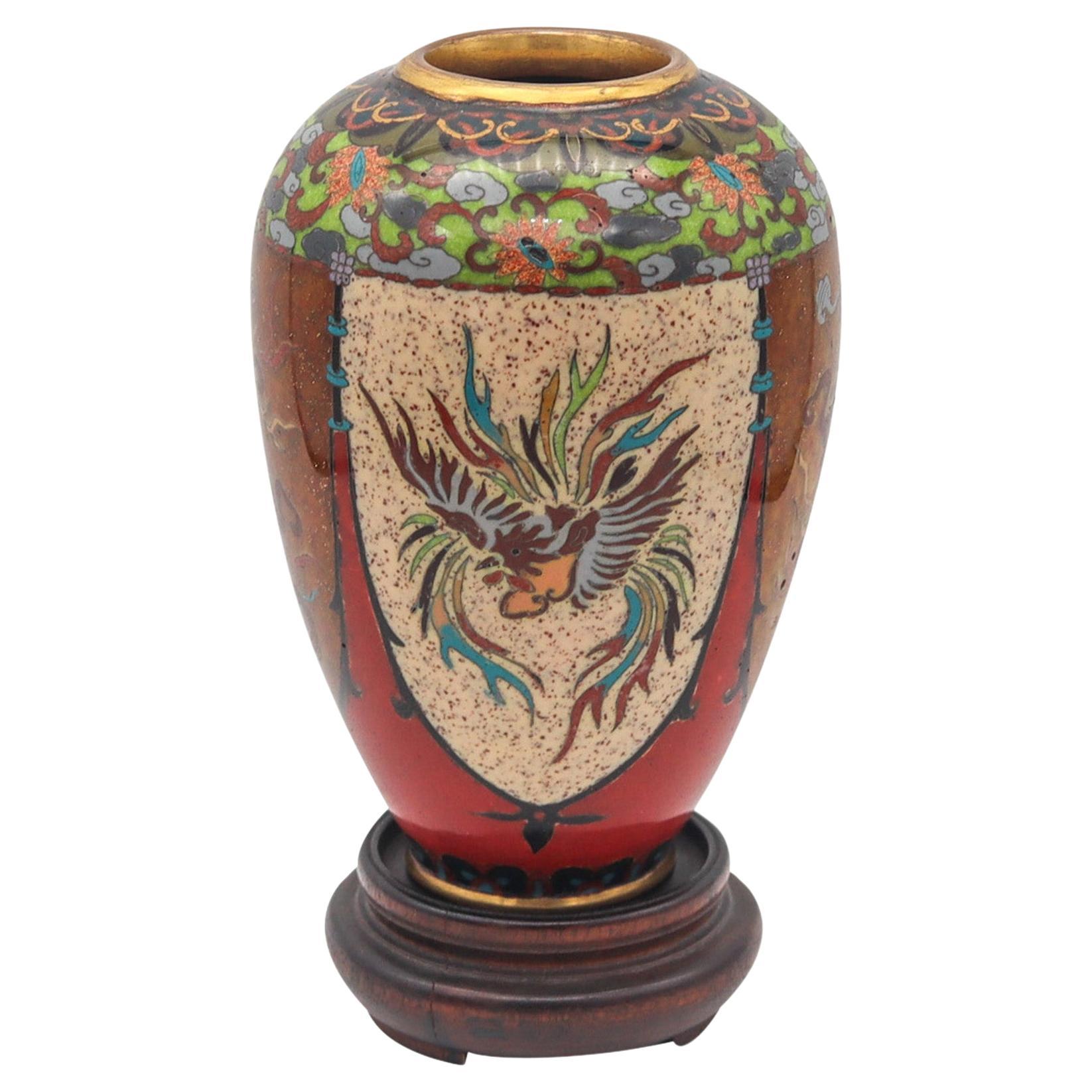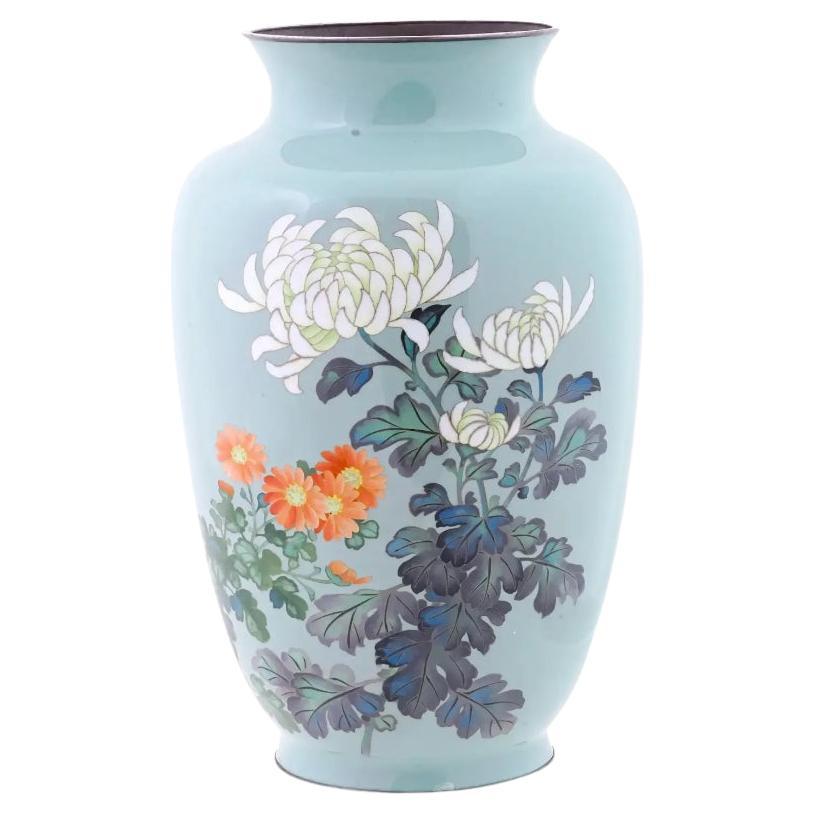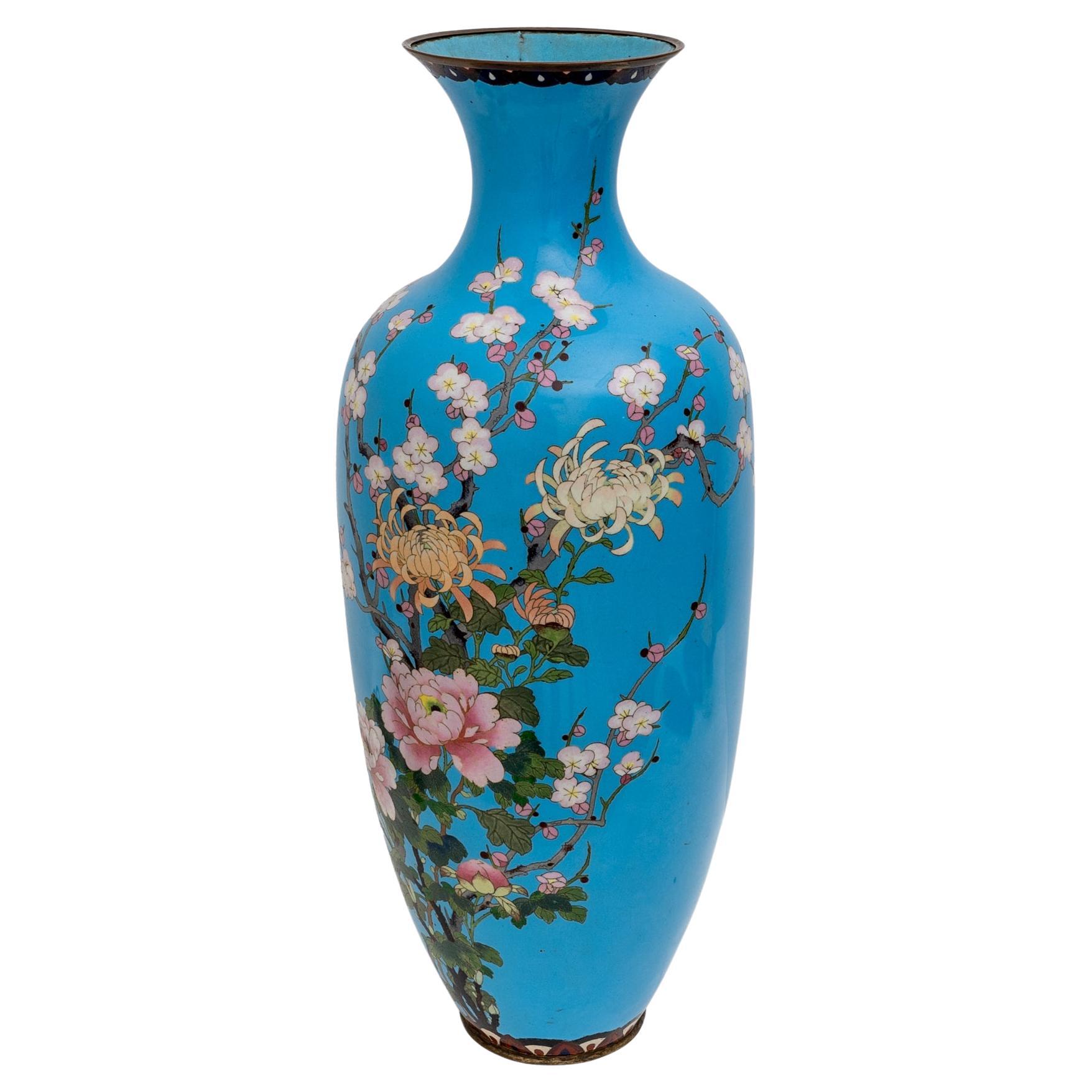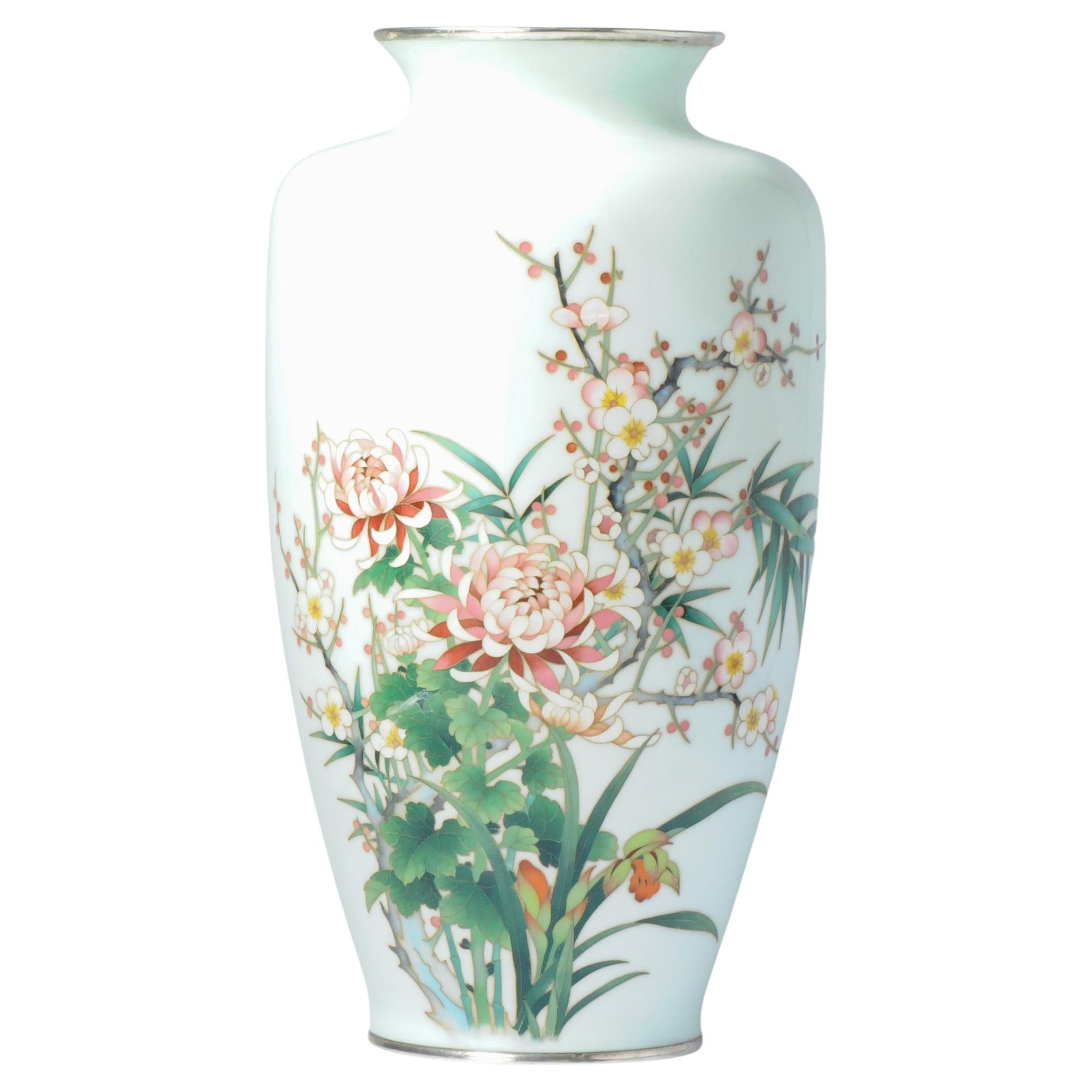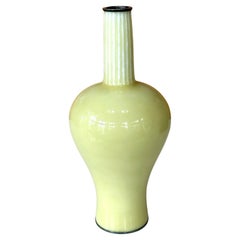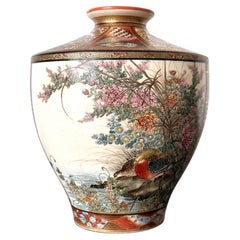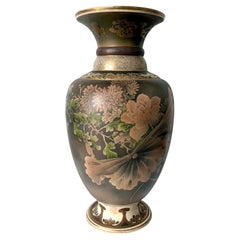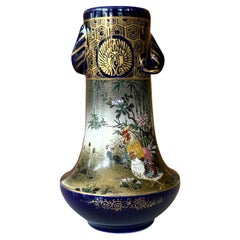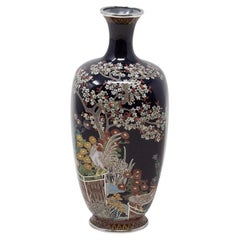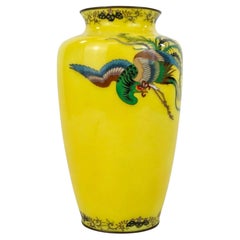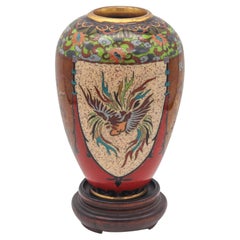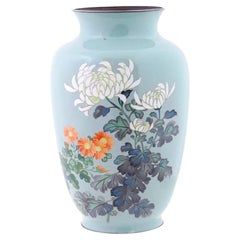Items Similar to Japanese Cloisonné Vase Ando Jubei with Storage Box
Want more images or videos?
Request additional images or videos from the seller
1 of 17
Japanese Cloisonné Vase Ando Jubei with Storage Box
$7,200
£5,468.99
€6,302.13
CA$10,139.38
A$11,241.01
CHF 5,907.59
MX$137,571.47
NOK 73,779.76
SEK 69,249.68
DKK 47,041.48
About the Item
A beautifully decorated cloisonné vase with silver rims by Ando Jubei (1876-1956), the celebrated Japanese Shippo studio. The piece is dated to late Meiji to early Showa period circa 1900-1920s. In a classic baluster form with a slightly waisted neck and flaring mouth rim, the vase radiates with its bright yellow background. Yusen shippo technique (wired cloisonné with silver), a typical technique from Owari province, was used brilliantly to depict a bundle of floral designs consisting of leafy stems of purple chrysanthemum and orange dahlias. Great attention was paid to the visual gradience of the color on the petals and leaves, rendering it a stylized but realistic imagery. With the silver wire exposed, the image also appears well defined, sharp and focused. Trimmed with silver on the lip and the base, there is a two-character "jungin" (pure silver) mark on foot rim and Ando mark on the center of the base, with stand. The piece retains its original box cushioned with brocade pads and signed with title and artist (Carefully made by Jubei) and sealed. There is also an associated wood base of Chinese taste for display. It was mostly likely made for an important client based on how it was titled, signed and packed.
- Creator:Ando Jubei (Maker)
- Dimensions:Height: 11 in (27.94 cm)Diameter: 6.75 in (17.15 cm)
- Style:Japonisme (Of the Period)
- Materials and Techniques:
- Place of Origin:
- Period:
- Date of Manufacture:1900s-1920s
- Condition:Wear consistent with age and use. Fine condition with only minor wear and tarnishing and surface scratches to silver. Wood box shows lots of age and patina, as shown.
- Seller Location:Atlanta, GA
- Reference Number:1stDibs: LU945025462812
About the Seller
4.9
Platinum Seller
Premium sellers with a 4.7+ rating and 24-hour response times
Established in 2006
1stDibs seller since 2010
567 sales on 1stDibs
Typical response time: <1 hour
- ShippingRetrieving quote...Shipping from: Atlanta, GA
- Return Policy
Authenticity Guarantee
In the unlikely event there’s an issue with an item’s authenticity, contact us within 1 year for a full refund. DetailsMoney-Back Guarantee
If your item is not as described, is damaged in transit, or does not arrive, contact us within 7 days for a full refund. Details24-Hour Cancellation
You have a 24-hour grace period in which to reconsider your purchase, with no questions asked.Vetted Professional Sellers
Our world-class sellers must adhere to strict standards for service and quality, maintaining the integrity of our listings.Price-Match Guarantee
If you find that a seller listed the same item for a lower price elsewhere, we’ll match it.Trusted Global Delivery
Our best-in-class carrier network provides specialized shipping options worldwide, including custom delivery.More From This Seller
View AllJapanese Wireless Musen Cloisonne Vase by Ando Jubei
By Ando Jubei
Located in Atlanta, GA
A Japanese cloisonne vase in bottle-form made by Ando Jubei (1876-1963) circa 1910-20s (late Meiji to Taisho period). The vase features a completely smooth surface without showing any wire. The technique is known as Musen (hidden wire) in Japanese and was notoriously difficult to perfect, especially with piece like this with a relatively large continuous surface. The beguiling effect is to use enamel to mimic porcelain or even jade. This vase, with its ultra smooth surface and soft yellow color (Yellow was often associated with Japanese imperial household...
Category
Early 20th Century Japanese Meiji Metalwork
Materials
Silver, Enamel
Fine Japanese Satsuma Vase by Ryozan Okamoto for Yasuda Company Meiji Period
Located in Atlanta, GA
A finely decorated Japanese satsuma ceramic vase by Ryozan Okamoto (c.1820s-1910s) for Yasuda. Ryozan is the head artist working for Yasuda company, a Japanese ceramic makers and dea...
Category
Antique Early 1900s Japanese Meiji Ceramics
Materials
Ceramic
Large Japanese Satsuma Ceramic Vase Kinkozan
By Kinkozan
Located in Atlanta, GA
A large Japanese ceramic vase from the end of Meiji period circa 1890-1910s by Kinkozan (1645-1927). One of the largest studio manufacturers of the export ceramics at the time based in Kyoto. In the typical style of satsuma made at the turn of 20th century, the vase is elaborately decorated with a rather unusual kinran-de (gold paint) and green enamel highlight on a mottled brown background. The painterly decoration depicts a large seasonal floral arrangement in a circular fashion. Besides the obviously superb craftsmanship, what sets this particular vase apart from many lower quality and mass-produced pieces is its tone-on-tone color pallet that is visually somber and the small and sensitive details that heralds the change of the seasons. When the viewer goes beyond the first casual glimpse of the blossom and foliage, one would notice that on the edges of certain leaves as well as along the stalks, there accumulates a very thin layer of the white dust that represents the frost. The flower in bloom are chrysanthemums. Despite of being splendid, they are the messengers of the autumn. The large lotus leaf was subtly rendered in a bended and slightly withered manner, just past its prime. Although the lotus is still in bloom, the prominent seed pod indicates it may be the last for the season. The sentimental capture of the change of the seasons is not unusual in Japanese art. This vase poetically represents such a subtle transition from summer to fall, perhaps depicting the very first frost.
The neck of the vase is also slightly unusual with two rolled rings...
Category
Early 20th Century Japanese Meiji Ceramics
Materials
Ceramic
Fine Japanese Ceramic Satsuma Vase by Kinkozan
By Kinkozan
Located in Atlanta, GA
A miniature Japanese ceramic vase from the end of Meiji period circa 1880s- 1910s by Kinkozan (1645-1927). One of the largest studio manufacturers of the export ceramics at the time ...
Category
Early 20th Century Japanese Meiji Ceramics
Materials
Ceramic
Antique Japanese Imari Bottle Vase on Wood Stand
Located in Atlanta, GA
On offer is a large Japanese Imari ceramic bottle vase with elaborate surface design circa 19th century (late Meiji Period). The distinct shape of the bottle is called tea-whisk form and the rare prototype was found in the early Ko-Imari production dated back to 16-17th century of Edo period. The shape was designed specifically to store liquor. This revived bottle was made in the 19th century and showcases decoration and colors typical of Imari ware. A lady in kimono holding a fan under a Sakura tree is showcased in the front and the back, with underglaze blue contrasting the rich overglaze enamel and gold. On the two sides, raised relief borders enclose scenes of combatant dragons and tigers under plum trees, both rendered in great relief details and of sculptural quality. The base was marked in underglaze blue the archaic Chinese characters "Da Ming Cheng Hua Year Made...
Category
Antique 19th Century Japanese Meiji Ceramics
Materials
Ceramic
Exquisite Japanese Satsuma Vase by Seikozan
Located in Atlanta, GA
A miniature vase in elegant upright form reminiscent of the Chinese imperial Willow Leaf form made by Japanese studio Seikozan circa 1890-1910s (late Meiji Period). One of the many a...
Category
Antique 1880s Japanese Meiji Ceramics
Materials
Ceramic
You May Also Like
Japanese Meiji Period Cloisonne Enamel Vase by Ando Jubei
By Ando Jubei
Located in Newark, England
Free international shipping
Ando Cloisonne Company Mark
From our Japanese collection, we are delighted to introduce this Japanese Cloisonne Enamel Vase by Ando Jubei. The Cloisonn...
Category
Antique Early 1900s Japanese Meiji Metalwork
Materials
Enamel, Wire
A Magnificent Japanese Antique Cloisonne Enamel Vase By Ando Jubei. Taisho Era
Located in London, GB
A Magnificent Japanese Cloisonné Enamel Vase by Ando Jubei
Taisho Era-Early 20th Century
Of elegant ovoid form with a short waisted neck and everted rim, worked in polychrome ename...
Category
Early 20th Century Japanese Metalwork
Materials
Enamel
Japan 1890 Meiji Period Decorative Vase In Cloisonné Enamel With Wood Base
Located in Miami, FL
Japanese vase from the Meiji Period (1868-1912).
Beautiful antique decorative vase, created in Japan during the Meiji period (1868-1912), circa 1890s. It was carefully crafted in so...
Category
Antique 1890s Japanese Meiji Metalwork
Materials
Bronze, Enamel
$488 Sale Price / set
30% Off
Antique Japanese Cloisonne Enamel Meiji Era Vase By Gonda Hirosuke
Located in Long Island City, NY
An ancient Japanese vase with magnificent flower decoration made in a polychrome cloisonne enamel on a pale turquoise ground. Classic form for Ja...
Category
Antique Late 19th Century Japanese Meiji Vases
Materials
Enamel
19th Century Large Japan Vase "Cloisonne" With Floral Decoration, Meiji Period
Located in Puglia, Puglia
Large antique Japanese vase. Dating from the late Meiji period, 19th century.
Made of copper and brass with 'Cloisonne' polychrome enamel decorations.
Cloisonne is a very ancient t...
Category
Antique Late 19th Century Japanese Meiji Vases
Materials
Brass, Copper
Lovely Ando Jubei Early 20th C Antique Period Japanese Vase Flower Cloisonne
Located in Amsterdam, Noord Holland
Description
Made By Ando Jubei, early 20th century
Worked in copper wire with stalks of flowering spider chrysanthemums and plum and narcissus reserved on a pale-green ground, th...
Category
20th Century Japanese Meiji Ceramics
Materials
Porcelain
$4,552 Sale Price
20% Off
More Ways To Browse
Antique Storage Box
Cloisonne Vases
Antique Japanese Cloisonne Vase
Asian Storage Box
Seal Box
Orange Japanese Antique
Japanese Cushion
Japanese Metal Box
Cloisonne Box
Wood Box 1900s
Cloisonne Stand
Yellow Cloisonne
Cloisonne Enamel Box
Chinese Metal Box
Asian Box On Stand
Japanese Enamel Box
Antique Cloisonne Boxes
Antique Japanese Silver Box
